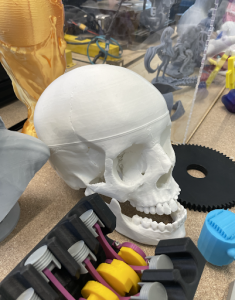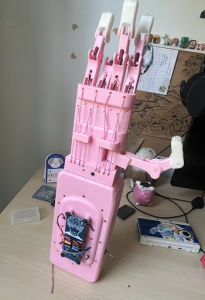Shaping the future of healthcare through new technology
BY JAMIE GHOLSON, STAFF WRITER
MIX Makerspace Manager and Events Coordinator Max Kazemzahed MFA, PhD, 3D printed an anatomically correct human skull. For Fernando Alarcon, it was a hand. Neither Kazemzahed nor Alarcon are medical engineers: they are simply people interested in 3D printing. They made these medical models and prostheses on Mason’s Fairfax campus at the MIX, Mason’s Innovation Exchange, during a 3D-printing workshop.
“It’s super easy to prototype prosthetic hands,” said sophomore Colin Jackson, a Makerspace Associate and Fabrication Lab assistant at the MIX. The MIX, located in Horizon Hall, is an “innovation, exploration, and creativity” facility, according to their website. Here, students have the opportunity to create and practice their skills in a range of mediums, including electronics, media, woodshop and more. The MIX offers various workshops, including a how-to for 3D models.
The evolution of 3D printing has transformed the landscape of manufacturing, paving the way for imaginative solutions in various industries.
In 1981, Dr. Hideo Kodama, a Japanese automobile designer, laid the foundation for one of the first 3D printers. 3D printing is a process that creates a physical object from a digital design by layering material. In 1986, Chuck Hull, known as the “Father of 3D Printing,” filed the first patent for stereolithography (SLA), a technique that uses photosensitive resin.
3D printing was introduced into the medical field in 2000 with its first use on dental implants and prosthetics. In 2011, Ivan Owen created the first prosthetic hand for $150, which took eight hours to assemble.
“3D printing is an experience thing over knowledge,” said Luke Baja-Ricketts, a sophomore and Makerspace Associate at the MIX. A little knowledge, however, can help.
Prosthetic limbs are made from three parts: prosthetic sockets, prosthetic components, and consumables. The prosthetic socket is the upper part that fits around the person’s residual limb. The prosthetic components are the actual prosthetics designed to meet the customer’s needs, specifically to fit the corresponding joint. These components are made from materials such as aluminum, stainless steel, or titanium. The last part, consumables, are the liners that go over the residual limb, designed for each client using silicone, Thermoplastic elastomers (TPE), and rubber.
Most of the students working with 3D printing at the MIX have first-hand experience creating prosthetics. Kazemzahed’s model skull and Alarcon’s prosthetic hand were made from PLA filament. Kazemzahed has also printed multiple 3D skulls for medical programs at Mason.
Jackson shared a personal connection to the technology. “My grandma’s knee is 3D printed out of titanium,” he said, highlighting the vast potential of 3D printing in medicine.
While not everyone at the MIX focuses on medical devices, the global market for such products is growing. A 2022 report by Grand View Research valued the 3D-printed prosthetics industry at $1.3 billion, projecting growth of 7.7% annually from 2023 to 2030.
“I think medical 3D printing is definitely going to continue to grow and get more affordable,” Jackson said.
The average cost of a traditional prosthetic leg can range from $1,500 to $8,000 depending on the type and extent of the amputation and how computerized it is. In contrast, a 3D-printed prosthetic can cost as little as $50, due to the lower cost of materials such as acrylonitrile butadiene styrene (ABS), bridge nylon, or lightweight titanium.
Traditional prosthetic fittings can take multiple casts to ensure a proper fit, causing the patient inconvenience and invasiveness. 3D printing eliminates the disruption. Technicians use a 3D scanner to create an accurate 3D model of the residual limb on the first try.
“You can 3D print in any material. There is no limitation to what you could do, just a limitation of how practical it is,” said Baja-Ricketts.
While there seems to be many advantages to 3D printing, there are some disadvantages. One significant issue is durability. Lower durability can mean the structure of the prosthetic breaks easily. 3D prints are built by each layer at a time. The layered construction process can result in weaker structures that are prone to breaking.
“If you were to take a log of wood and chop it from the top, it’s easy to split. But if you chop it from the side, it takes a lot longer”, Jackson explained.“3D printing can give you that strength but you still have one direction always being weaker because that is where the layer lines are.”
The future of 3D printing in the medical field looks promising. In the coming decades, researchers may even develop the ability to bioprint human limbs, joint cartilage, and transplant-ready organs using stem cells.





